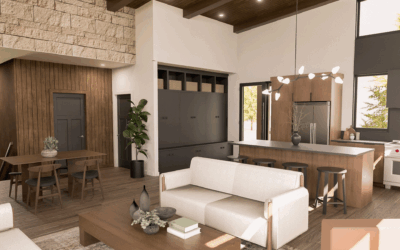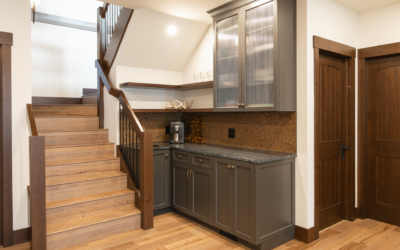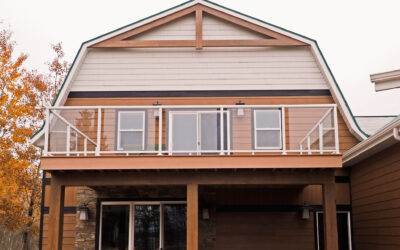Designing a great room is a rewarding endeavor. As the heart of your home, this space should blend comfort, style, and functionality. Here are 10 design tips to help you create a stunning great room.
1. Emphasize Open Space

A great room should feel open and airy. Opting for an open floor plan that combines the living, dining, and kitchen areas can enhance the sense of space. This design encourages a seamless flow between different activities and promotes a more social and inclusive atmosphere. It allows family members and guests to interact even if they are engaged in different activities. To achieve this, consider removing unnecessary walls and using large, open doorways. Furniture placement plays a critical role in maintaining an open feel. Avoid overstuffing the room with too many pieces; instead, select a few key items that serve multiple purposes. Strategic placement of furniture can create distinct zones without breaking the visual continuity. For example, a well-placed sofa can define the living area, while a dining table can segment the eating space. Remember, less is often more when aiming for an open and inviting great room.
2. Choose a Cohesive Color Palette

Selecting a cohesive color palette is crucial in creating a unified and harmonious great room. A well-chosen color scheme can tie together the different areas of the room, making the space feel more connected and aesthetically pleasing. Start with a base of neutral colors like whites, grays, or beiges, which provide a versatile backdrop that can be easily updated with accessories. Neutrals also help to enhance the natural light and make the room feel larger. Once you have your base, add pops of color through accents like cushions, rugs, and artwork. These accents can be changed seasonally or as trends evolve, allowing for easy and cost-effective updates. It’s important to maintain consistency in the color palette across all elements of the room, including furniture, wall paint, and accessories. This doesn’t mean everything has to match perfectly, but the colors should complement each other and contribute to a cohesive look.
3. Incorporate Natural Light

Natural light is a critical component in making a great room feel welcoming and spacious. Large windows, skylights, and glass doors are excellent ways to bring in ample daylight. Consider the placement of windows to maximize light throughout the day, especially in areas where you spend the most time. South-facing windows, for example, provide consistent light and warmth. If privacy is a concern, use sheer curtains or blinds that allow light to filter through while maintaining privacy. Reflective surfaces, such as mirrors and glass furniture, can also help to bounce light around the room, enhancing the natural brightness. Additionally, choose light-colored walls and furnishings, which reflect light rather than absorb it, contributing to a more open and airy feel. Remember that natural light can change the appearance of colors and textures throughout the day, so it’s wise to test your color choices under different lighting conditions.
4. Select Versatile Furniture

Image By New Copper Photography
Versatile furniture is key to a functional and adaptable great room. Pieces that serve multiple purposes can help you make the most of your space and accommodate different needs. For instance, a modular sofa can be rearranged to suit various seating arrangements or to open up space for activities. Extendable dining tables are another great option, offering flexibility for both everyday meals and larger gatherings. Look for furniture with built-in storage to help keep the room organized and clutter-free. Ottomans with storage space, coffee tables with shelves, and benches with hidden compartments can provide extra storage without sacrificing style. When selecting furniture, consider the scale and proportion of each piece in relation to the room. Oversized furniture can overwhelm a space, while too-small pieces may look out of place. Aim for a balanced mix of sizes that fit comfortably within the room without crowding it.
5. Create Defined Areas

Image By New Copper Photography
Defining different areas within a great room helps to organize the space and give each function its own identity. This can be achieved through strategic placement of furniture, rugs, and lighting. For example, an area rug can anchor the living space, while a pendant light can highlight the dining area. Arranging furniture in groupings, such as placing sofas and chairs around a coffee table, creates a natural conversation area. Similarly, positioning the dining table near the kitchen or windows can designate the eating space. Room dividers, bookcases, and even tall plants can act as subtle partitions, delineating different zones without obstructing the open feel. Lighting plays a crucial role in defining areas as well. Use a mix of overhead lights, floor lamps, and table lamps to create different moods and highlight specific parts of the room. Dimmers and smart lighting systems offer flexibility in adjusting the ambiance to suit various activities and times of day.
6. Focus on a Focal Point

A focal point draws the eye and adds visual interest to your great room. It can be a striking architectural feature, such as a fireplace, a large window with a beautiful view, or a piece of artwork. Identifying a focal point helps to anchor the room and guide the arrangement of furniture and decor. Once you’ve chosen your focal point, arrange seating and other elements to enhance and highlight it. For example, if your focal point is a fireplace, arrange sofas and chairs to face it, creating a cozy gathering spot. If it’s a large window, position furniture to take advantage of the view and natural light. Accentuate the focal point with complementary decor, such as a mirror above the fireplace, or a pair of statement sconces flanking a piece of art. Keeping the surrounding area relatively simple allows the focal point to stand out and become the centerpiece of the room.
7. Add Texture and Layers

Introducing various textures and layers adds depth and warmth to your great room, making it feel more inviting and cozy. Use a mix of materials such as wood, metal, glass, and textiles to create a rich and tactile environment. Soft furnishings like cushions, throws, and rugs add comfort and can easily be swapped out to refresh the look of the room. Consider layering different textures in a single area, such as a plush rug under a sleek coffee table, or a mix of patterned cushions on a neutral sofa. Textiles can also be used to introduce color and pattern, adding visual interest without overwhelming the space. Incorporate natural textures like wood and stone to bring a touch of the outdoors in and create a sense of harmony with nature. Balancing different textures and layers helps to create a dynamic and visually appealing room that feels comfortable and lived-in.
8. Use Statement Lighting

Statement lighting fixtures are both functional and decorative, enhancing the ambiance of your great room while serving as a design element. Chandeliers, pendant lights, and floor lamps can make bold statements and add character to the space. When choosing lighting, consider the room’s overall style and how the fixtures will complement other design elements. For example, a modern chandelier can add a touch of elegance to a contemporary room, while a rustic pendant light can enhance a cozy, farmhouse-style space. Layering different types of lighting, such as ambient, task, and accent lighting, ensures that the room is well-lit for various activities. Dimmer switches and smart lighting systems allow you to adjust the light levels to create the desired mood and atmosphere. In addition to overhead lighting, incorporate table lamps and floor lamps to add warmth and provide focused light for reading or other tasks.
9. Incorporate Natural Elements

Bringing natural elements into your great room adds a sense of tranquility and connection to the outdoors. Wood, stone, and plants are excellent choices for introducing nature-inspired textures and colors. Wooden furniture, beams, and floors add warmth and character, while stone accents, such as a fireplace or wall feature, provide a rustic touch. Indoor plants not only enhance the aesthetic appeal but also improve air quality and contribute to a healthier living environment. Choose a variety of plants in different sizes and types to create a lush, green oasis. Arrange them on shelves, in corners, and on tabletops to add life and color to the room. Natural materials and greenery can be combined with other design elements to create a balanced and harmonious space. Incorporating these elements helps to create a relaxing and inviting atmosphere, making your great room a comfortable retreat.
10. Add Personal Touches

Personal touches make your great room uniquely yours and add a sense of warmth and character. Incorporate items that reflect your personality and interests, such as family photos, travel souvenirs, or artwork. These pieces tell a story and create a connection between you and the space. Displaying personal items on shelves, walls, and tabletops adds a layer of authenticity and makes the room feel lived-in and loved. Consider creating a gallery wall with a mix of photos, artwork, and mementos that have special meaning to you. Mixing new and old items, such as heirlooms with contemporary decor, creates a rich and eclectic look. Personal touches also extend to the practical aspects of the room, such as incorporating favorite colors, textures, and styles that resonate with you. Ultimately, a great room filled with personal touches is one that feels welcoming and truly reflective of your unique style.
Creating a great room that is both beautiful and functional is achievable with these design tips. Focus on open space, cohesive color palettes, and integrating natural elements to transform your great room into the perfect gathering spot for family and friends.











